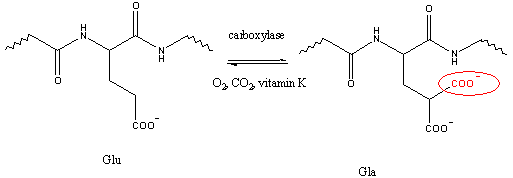| Home |
| Introduction |
| Historical |
| Synthesis |
| Characterisation |
| Indications |
| Blood Coagulation |
| Mechanism of Action |
| Efficacy |
| Side Effects |
| The Future |
| Bibliography |
Mechanism of Action
To understand the mechanism of action
of warfarin, we have to look in more detail at part of the
structure of some coagulation factors9.
Factors II( Prothrombin), VII, IX and X have, at their amino terminus,
a series of glutamate residues (Glu)-typically 9 to 12. These factors
are vitamin K dependent. In a post translational modification in
the liver, the glutamate residues are carboxylated in presence of O2,
CO2 and the enzyme carboxylase, to form γ- carboxyglutamate
(Gla) residues. Vitamin K is essential for the process.

This carboxylation is essential for the proper functioning of the clotting factors. The newly-formed Gla residues chelate strongly and selectively with Ca2+ (factor IV) and the latter forms ion bridges to anionic phosphate head groups of phospholipid membrane surfaces.

As was mentioned previously, binding at the membrane surface is a critical
step in the process of activation of the clotting factors.
The carboxylation process is associated with the vitamin K cycle. In this cycle, vitamin K is reduced by enzyme Vitamin K reductase to its hydroquinone form, vitamin KH2 , which then catalyses the carboxylation process and is converted to its epoxide (vitamin KO). This is then converted back to vitamin K by the enzyme Vitamin KO reductase.
